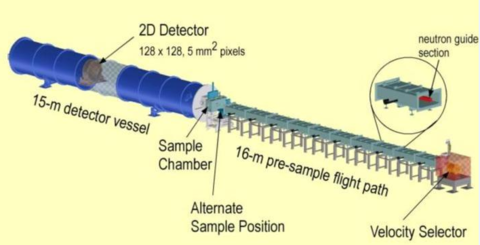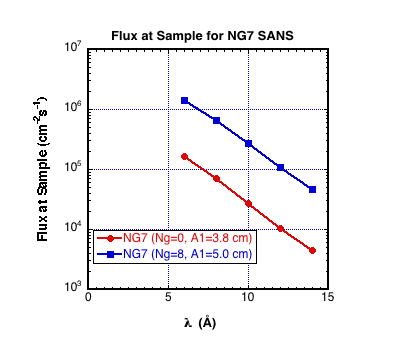NG7 SANS - Small Angle Neutron Scattering

The 30 meter long Small-Angle Neutron Scattering (SANS) instrument on neutron guide NG7 was the first new instrument to go into operation in the NCNR guide hall in May 1991. Jointly developed and sponsored by the NCNR, the ExxonMobil Research and Engineering Co., and the University of Minnesota, the instrument has undergone a number of improvements over the years to remain, along with its near-twin on guide NGB, the best such instruments in the U.S. The improvements, including a higher resolution 2D detector, and focusing refractive lenses have extended the Q-range of the instrument from 0.01 nm-1 to 7.0 nm-1 to elucidate structural features in materials ranging from roughly 1 nm to over 500 nm to be probed. A polarizing guide and RF flipper were installed in 2014. Fully polarized beam measurements are possible with the use of a 3He analyzer.

Specifications/Capabilities
| Q-Range | 0.01 nm-1 to 7.0 nm-1 |
| Size Regime | ~1 nm to ~500 nm |
| Source | Neutron Guide (NG-7), cross-section: 50 mm x 50 mm |
| Monochromator | Mechanical velocity selector with variable speed and pitch |
| Wavelength Range | 4.5 Å to 20.0 Å |
| Wavelength Resolution | 11% to 30% Δλ/λ (FWHM) |
| Source-to-Sample Distance | 4 m to 16 m in 1.5m steps via insertion of guide sections |
| Collimation | Circular pinhole collimation or focusing biconcave lenses |
| Sample Size | 5 mm to 25 mm diameter |
| Sample-to-Detector Distance | 1.0 m to 15.3 m continuously variable |
| Detector | 640 mm x 640 mm 3He position-sensitive proportional counter with a 5.08 mm x 5.08 mm resolution |
| Optional Capabilities |
|
| Power Outlets |
220V, 30A, 1-phase - Qty. 3 208V, 30A, 3-phase - Qty. 2 208V, 60A, 3-phase - Qty. 2 110V, 30A, 1-phase - Numerous UPS and non-UPS |
Scientific Opportunities/Applications
How NG7 SANS Beam Time is Typically Allocated in Each 38 Day Cycle:
- 3 days - ExxonMobil Co.
- 3 days - University of Minnesota
- 10 days minimum - BTAC Proposals
- Balance (22 days or less) - Proprietary and Collaborative Research

